Experimental Characterization of Stress- and Strain-Dependent Stiffness in Grouted Rock Masses
Abstract
:1. Introduction
2. Materials
3. Experimental Study
3.1. Experimental Setup
3.1.1. Quasi-Static Resonant Column Test (QRCT)
3.1.2. Rock Mass Dynamic Test (RMDT)
3.2. Experimental Procedure
4. Results and Discussion
4.1. Effects of Grouting on Jointed Rock Mass
4.2. Effects of Initial Joint Roughness on Grouted Rock Mass
4.3. Effects of Grouted Joint Thickness on Grouted Rock Mass
5. Analysis
6. Conclusions
- (1)
- The presence of discontinuous joints in the rock specimens resulted in attenuation and energy losses at the rock-joint interface, which contributed to the total loss in the medium and enabled more stress-dependent compressibility. As the grout material filled the discontinuous joints, the joint filling and adhesive effects of the grout bound the rock disks into a single grouted rock column. This resulted in increased shear stiffness and decreased stress sensitivity.
- (2)
- Grouting of rock joints led to improved shear stiffness and decreased stress-dependency for all tested stress and strain levels. Both the intact grout and planar-grouted rock specimens (A1 and A3) displayed similar degradation characteristics with increasing shear strain, which indicated that the strain-dependent characteristics of grouted rocks are governed by the properties of the grout material.
- (3)
- Rough interlocked joints (B2) have higher shear stiffness compared to planar joints (B1) as the rough joint surface allows interlocking and increased contact area between contiguous joints. Rough-jointed joints also displayed a much shorter linear range for strain-dependent modulus degradation.
- (4)
- Grouted rough and planar joints (B3 and B4) displayed similar increases in shear modulus and strain-dependent characteristics with grouting. This indicated that the strain-dependent shear stiffness of the grouted rocks is predominantly governed by the properties of the grout material. The stress-dependent stiffness is influenced by the initial joint roughness, where the rough interlocked joints displayed a unique shear stiffness for both ungrouted and grouted conditions (B2 and B4).
- (5)
- The rock-grout interface contributes to the shear behavior of the grouted rock mass (shear contribution zone) while the other parts of the grouted joint contributed to the joint filling effect (joint filling zone). The shear contribution zone is limited to the rock-grout interface and is independent of the grouted joint thickness. Increased grouted joint thickness implies larger contribution of the grout properties, resulting in decreased shear stiffness of the overall grouted rock specimen. The largest shear modulus increase would be observed when the joint filling zone is minimized with the maximum shear contribution zone.
- (6)
- The range of α (wave velocity at 1 kPa axial stress) and β (stress sensitivity) values of jointed rocks follow the general trend line outlined in Cha et al. (2014) [39]. Grouts and grouted rocks form a similar unique distribution characterized by low stress sensitivity and high wave velocities. This similarity indicates that the properties of the grout material greatly influences the stress- dependent wave propagation and stiffness of grouted rocks. The range of α and β values for grouts and grouted rocks vary depending on the stiffness of the grout material.
Acknowledgments
Author Contributions
Conflicts of Interest
References
- Barton, N. The theory behind high pressure grouting Pt 1. In Tunnels & Tunnelling International; Progressive Media Markets, Ltd.: London, UK, 2004; pp. 33–35. [Google Scholar]
- Garshol, K.F. Pre-Excavation Grouting in Tunneling, 1st ed.; UGC International: Lyon, France, 2007. [Google Scholar]
- Grøv, E.; Woldmo, O. Modern pre-grouting technology in Norway. In Grouting and Deep Mixing, Proceedings of the Fourth International Conference on Grouting and Deep Mixing, New Orleans, LA, USA, 15–18 February 2012; American Society of Civil Engineers: Reston, VA, USA, 2012. [Google Scholar]
- Yang, M.J.; Yue, Z.Q.; Lee, P.K.; Su, B.; Tham, L.G. Prediction of grout penetration in fractured rocks by numerical simulation. Can. Geotech. J. 2002, 39, 1384–1394. [Google Scholar] [CrossRef] [Green Version]
- Lee, J.S.; Bang, C.S.; Mok, Y.J.; Joh, S.H. Numerical and experimental analysis of penetration grouting in jointed rock masses. Int. J. Rock Mech. Min. 2000, 37, 1027–1037. [Google Scholar] [CrossRef]
- Saeidi, O.; Stille, H.; Torabi, S.R. Numerical and analytical analyses of the effects of different joint and grout properties on the rock mass groutability. Tunn. Undergr. Sp. Technol. 2013, 39, 11–25. [Google Scholar] [CrossRef]
- Lombardi, G. Grouting of rock masses. In Grouting and Ground Treatment, Proceedings of the Third International Conference, Grouting and Ground Treatment New Orleans, LA, USA, 10–12 February 2003; Geotechnical Special Publication No. 120; American Society of Civil Engineers: Reston, VA, USA, 2003. [Google Scholar]
- Hässler, L.; Håkansson, U.; Stille, H. Computer-simulated flow of grouts in jointed rock. Tunn. Undergr. Sp. Technol. 1992, 7, 441–446. [Google Scholar] [CrossRef]
- Eriksson, M.; Stille, H.; Andersson, J. Numerical calculations for prediction of grout spread with account for filtration and varying aperture. Tunn. Undergr. Sp. Technol. 2000, 15, 353–364. [Google Scholar] [CrossRef]
- Fransson, Å.; Tsang, C.F.; Rutqvist, J.; Gustafson, G. A new parameter to assess hydromechanical effects in single-hole hydraulic testing and grouting. Int. J. Rock Mech. Min. 2007, 44, 1011–1021. [Google Scholar] [CrossRef]
- Knill, J.L. The application of seismic methods in the prediction of grout take in rock. In Insitu Investigation in Soils and Rocks, Proceedings of the Conference organized by the British Geotechnical Society in London, 13-15 May 1969; British Geotechnical Society: London, UK, 1970. [Google Scholar]
- Vik, E.A.; Sverdrup, L.; Kelley, A.; Storhaug, R.; Beitnes, A.; Boge, K.; Grepstad, G.K.; Tveiten, V. Experiences from environmental risk management of chemical grouting agents used during construction of the Romeriksporten tunnel. Tunn. Undergr. Sp. Technol. 2000, 15, 369–378. [Google Scholar] [CrossRef]
- Madenga, V.; Zou, D.H.; Zhang, C. Effects of curing time and frequency on ultrasonic wave velocity in grouted rock bolts. J. Appl. Geophys. 2006, 59, 79–87. [Google Scholar] [CrossRef]
- Hernqvist, L.; Fransson, Å.; Gustafson, G.; Emmelin, A.; Eriksson, M.; Stille, H. Analyses of the grouting results for a section of the APSE tunnel at Äspö Hard Rock Laboratory. Int. J. Rock Mech. Min. 2009, 46, 439–449. [Google Scholar] [CrossRef]
- Turk, N.; Dearman, W.R. Assessment of grouting efficiency in a rock mass in terms of seismic velocities. Bull. Eng. Geol. Environ. 1989, 36, 101–108. [Google Scholar] [CrossRef]
- Barton, N. Some new Q-value correlations to assist in site characterisation and tunnel design. Int. J. Rock Mech. Min. 2002, 39, 185–216. [Google Scholar] [CrossRef]
- Barton, N. Rock Quality, Seismic Velocity, Attenuation and Anisotropy, 1st ed.; CRC Press: Boca Raton, FL, USA, 2007. [Google Scholar]
- Khandelwal, M.; Ranjith, P.G. Correlating index properties of rocks with P-wave measurements. J. Appl. Geophy. 2010, 71, 1–5. [Google Scholar] [CrossRef]
- Fratta, D.; Santamarina, J.C. Shear wave propagation in jointed rock: State of stress. Geotechnique 2002, 52, 495–505. [Google Scholar] [CrossRef]
- Cha, M.; Cho, G.C.; Santamarina, J.C. Long-wavelength P-wave and S-wave propagation in jointed rock masses. Geophysics 2009, 74, E205–E214. [Google Scholar] [CrossRef]
- Mohd-Nordin, M.M.; Song, K.I.; Cho, G.C.; Mohamed, Z. Long-wavelength elastic wave propagation across naturally fractured rock masses. Rock Mech. Rock Eng. 2014, 47, 561–573. [Google Scholar] [CrossRef]
- Chong, S.H.; Kim, J.W.; Cho, G.C. Rock mass dynamic test apparatus for estimating the strain-dependent dynamic properties of jointed rock masses. Geotech. Test J. 2014, 37, 311–318. [Google Scholar] [CrossRef]
- Perino, A.; Barla, G. Resonant column apparatus tests on intact and jointed rock specimens with numerical modelling validation. Rock Mech. Rock Eng. 2015, 48, 197–211. [Google Scholar] [CrossRef]
- Sebastian, R.; Sitharam, T.G. Long-wavelength propagation of waves in jointed rocks-study using resonant column experiments and model material. Geomech. Geoeng. 2016, 11, 1–16. [Google Scholar] [CrossRef]
- Acar, Y.B.; El-Tahir, E.T.A. Low strain dynamic properties of artificially cemented sand. J. Geotech. Eng. 1986, 112, 1001–1015. [Google Scholar] [CrossRef]
- Maher, M.H.; Ro, K.S.; Welsh, J.P. Cyclic undrained behavior and liquefaction potential of sand treated with chemical grouts and microfine cement (MC-500). Geotech. Test J. 1994, 17, 159–170. [Google Scholar]
- Delfosse-Ribay, E.; Djeran-Maigre, I.; Cabrillac, R.; Gouvenot, D. Shear modulus and damping ratio of grouted sand. J. Soil Dyn. Eq. Eng. 2011, 24, 461–471. [Google Scholar] [CrossRef]
- Mollamahmutoglu, M.; Yilmaz, Y. Engineering properties of medium-to-fine sands injected with microfine cement grout. Mar. Georesour. Geotechnol. 2011, 29, 95–109. [Google Scholar] [CrossRef]
- Porcino, D.; Marcianò, V.; Granata, R. Static and dynamic properties of a lightly cemented silicate-grouted sand. Can. Geotechnol. J. 2012, 49, 1117–1133. [Google Scholar] [CrossRef]
- Warner, J. Practical Handbook of Grouting: Soil, Rock, and Structures, 1st ed.; John Wiley & Sons, Inc.: Hoboken, NJ, USA, 2004. [Google Scholar]
- Gouvenot, D. State of the art in European grouting. Proc. Inst. Civ. Eng. Ground Improv. 1998, 2, 51–67. [Google Scholar] [CrossRef]
- Park, H.G.; Sung, S.K.; Park, C.G.; Won, J.P. Influence of a C12A7 mineral-based accelerator on the strength and durability of shotcrete. Cem. Concr. Res. 2008, 38, 379–385. [Google Scholar] [CrossRef]
- Barton, N.; Choubey, V. The shear strength of rock joints in theory and practice. Rock Mech. Rock Eng. 1977, 10, 1–54. [Google Scholar] [CrossRef]
- Cha, M.; Cho, G.C. Compression wave velocity of cylindrical rock specimens: Engineering modulus interpretation. Jpn. J. Appl. Phys. 2007, 46, 4497–4499. [Google Scholar] [CrossRef]
- Hardin, B.O.; Drnevich, V.P. Shear modulus and damping in soils: Design equations and curves. J. Soil Mech. Found. Div. ASCE 1972, 98, 667–692. [Google Scholar]
- Kim, J.; Song, K.I.; Cho, G.C.; Lee, S.W. Evaluation of the time-dependent characteristics of grouted sand using an elastic wave. Mod. Phys. Lett. B 2008, 22, 899–904. [Google Scholar] [CrossRef]
- Mohd-Nordin, M.M.; Song, K.I.; Kim, D.; Chang, I. Evolution of joint roughness degradation from cyclic loading and its effect on the elastic wave velocity. Rock Mech. Rock Eng. 2016, 49, 3363–3370. [Google Scholar] [CrossRef]
- Hardin, B.O.; Richart, F., Jr. Elastic wave velocities in granular soils. J. Soil Mech. Found. Div. ASCE 1963, 89, 33–65. [Google Scholar]
- Cha, M.; Santamarina, J.C.; Kim, H.S.; Cho, G.C. Small-strain stiffness, shear-wave velocity, and soil compressibility. J. Geotechnol. Geoenviron. Eng. 2014, 140, 06014011. [Google Scholar] [CrossRef]
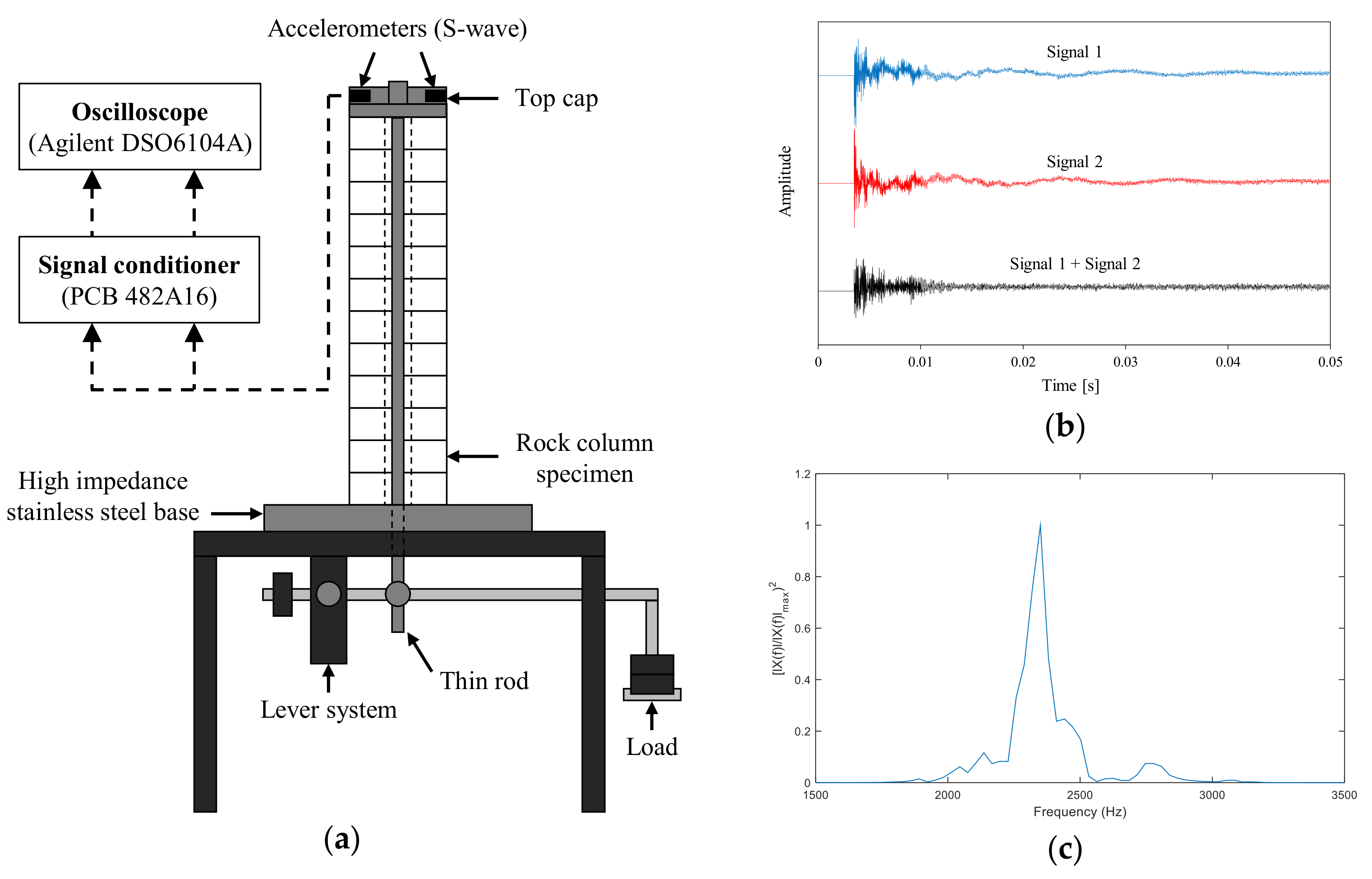
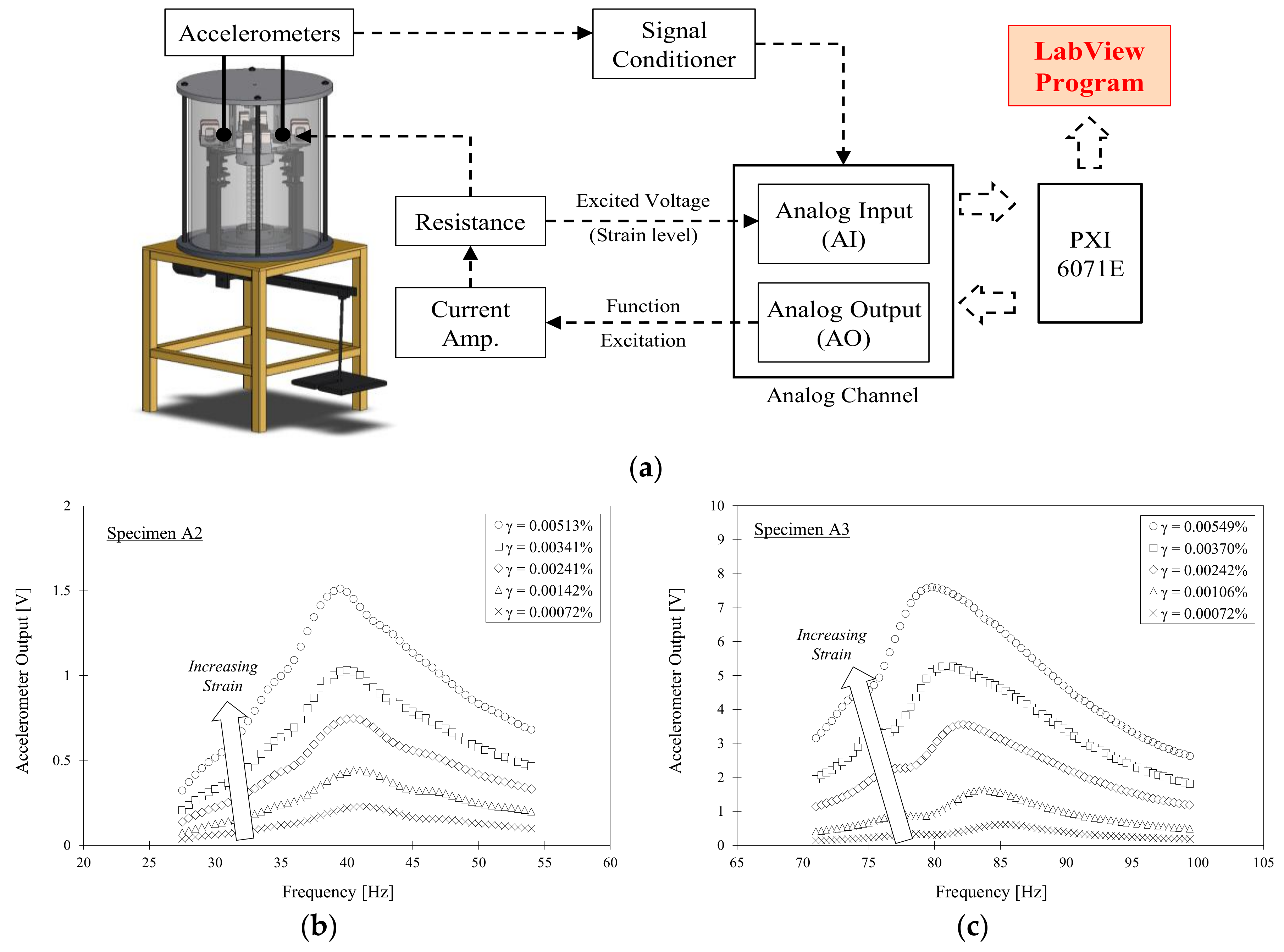


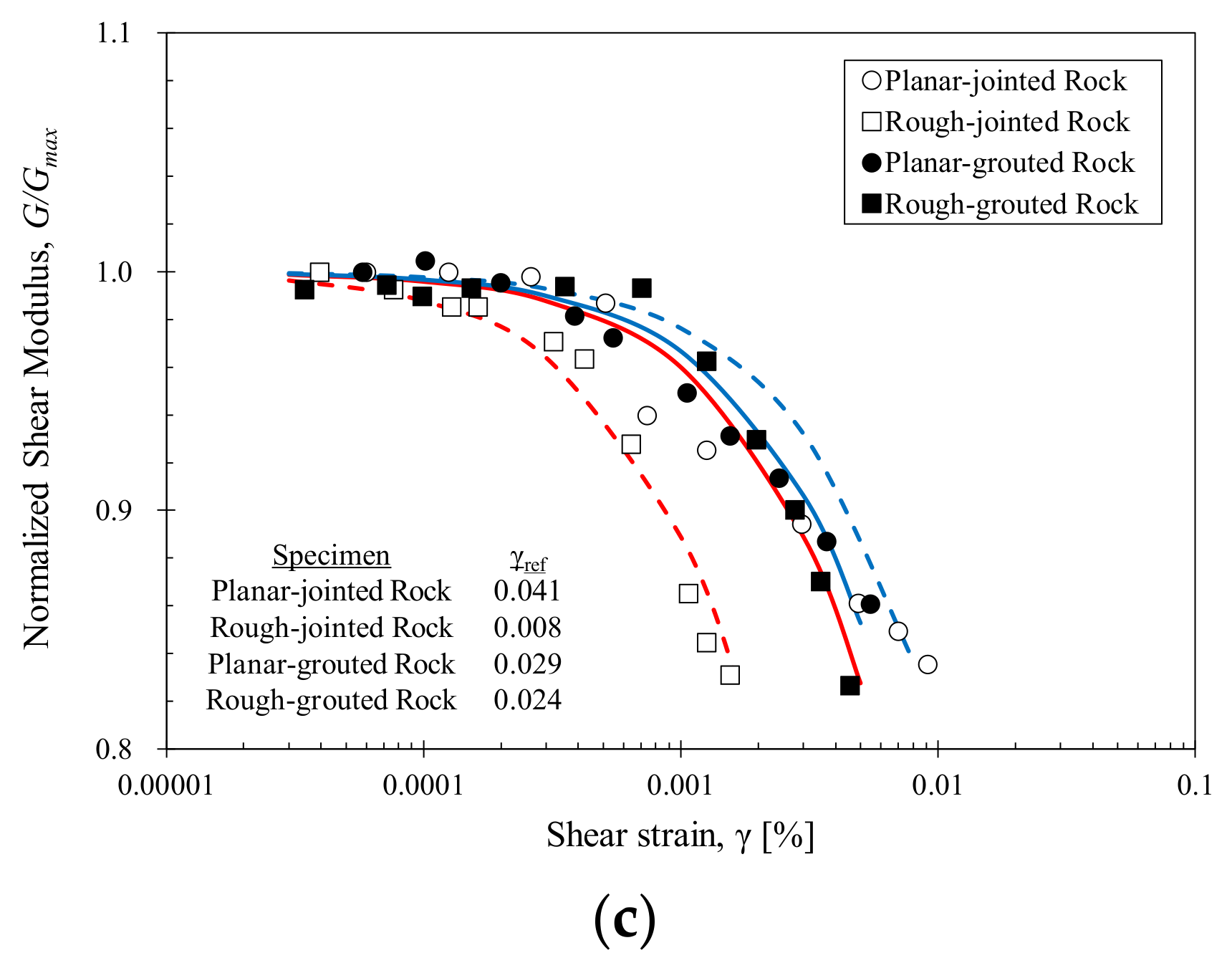
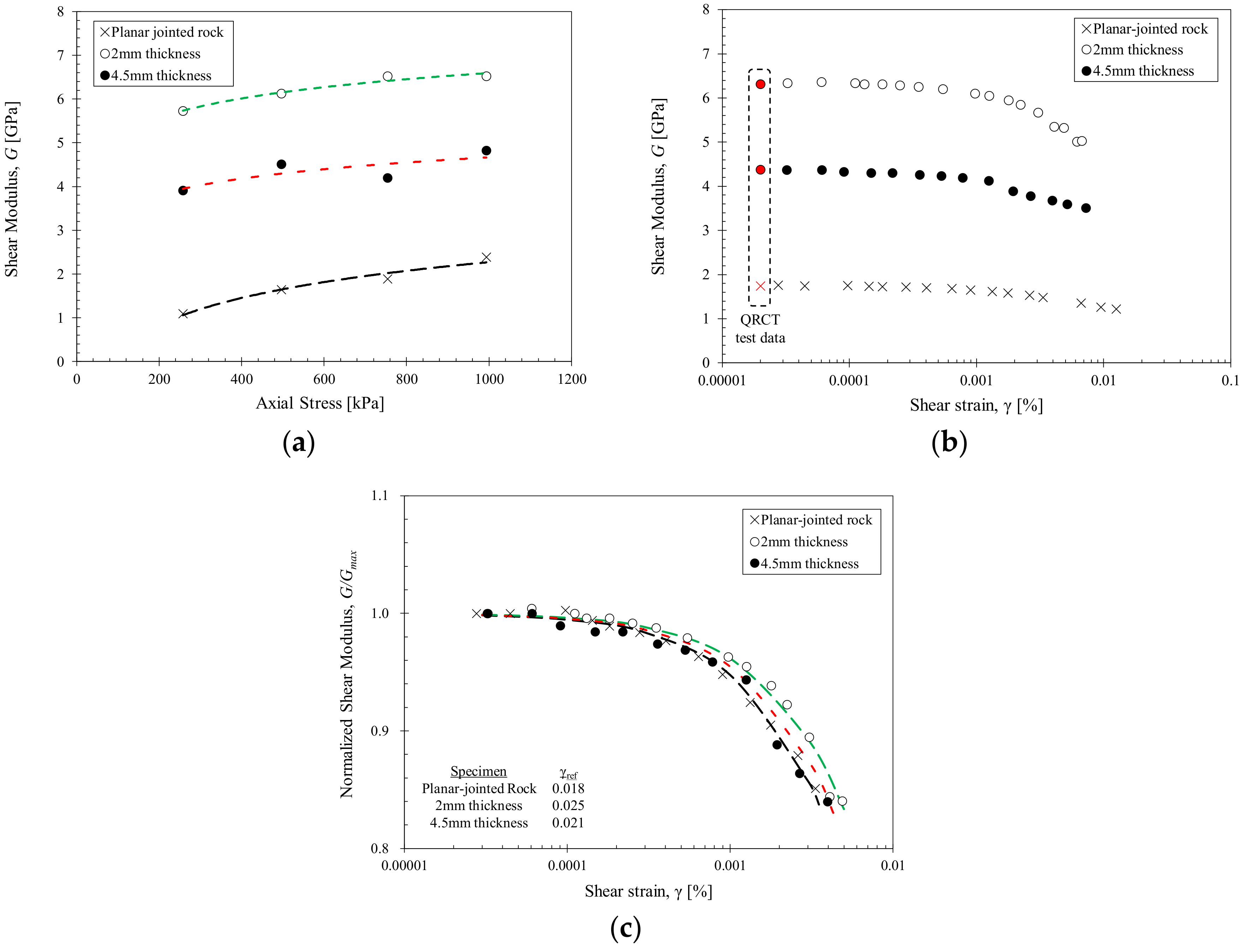
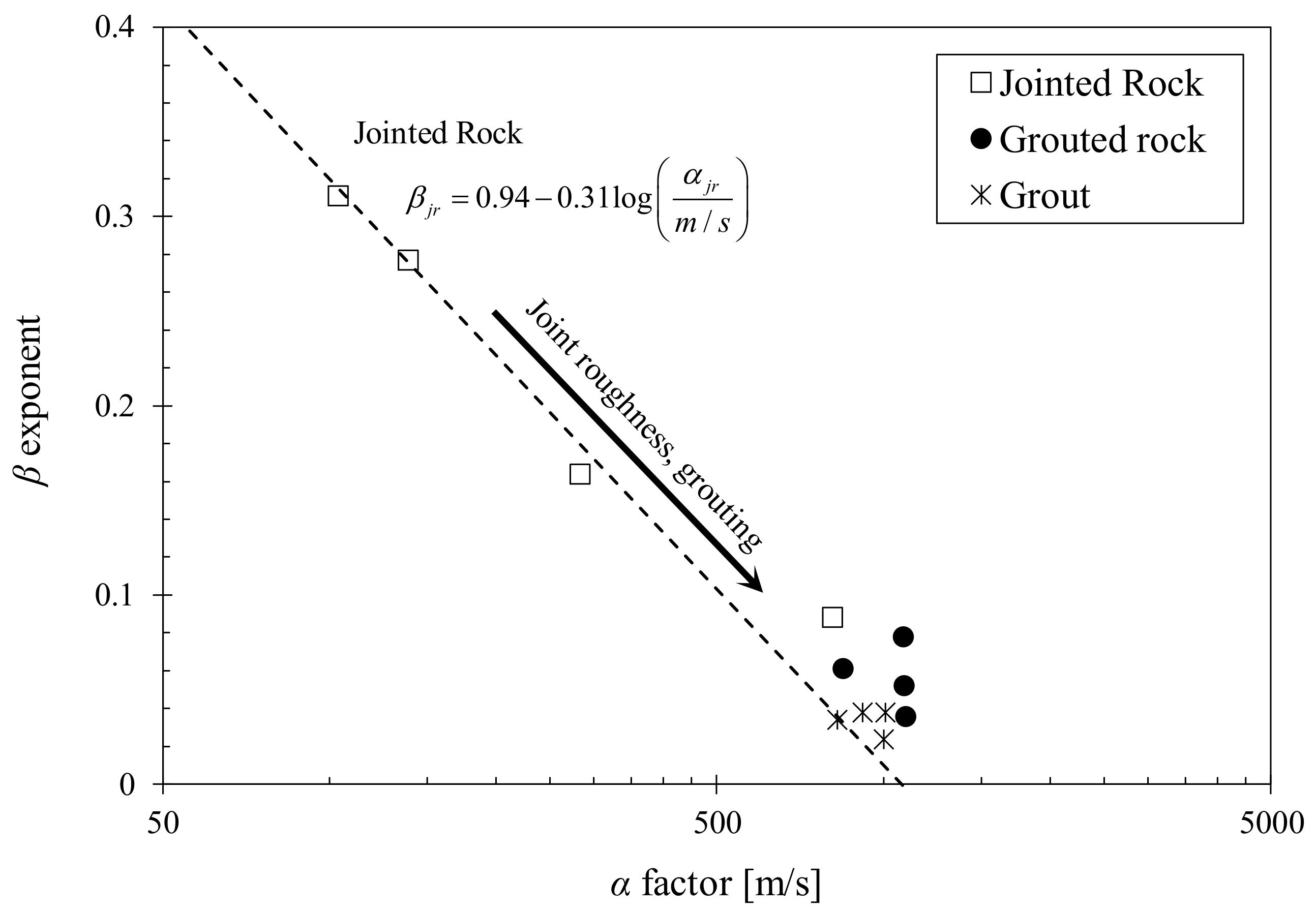
| Configuration | Geochang Granite | Machun Granite | Grout 1 | ||||
|---|---|---|---|---|---|---|---|
| Joint Condition | Intact | Planar | Planar | Rough | Planar | Planar | Intact |
| Average grouted thickness (mm) | - | 1.5 | 1.5 | 1.5 | 2.0 | 4.5 | - |
| Outer diameter (mm) | 62.4 | 62.4 | 51.5 | 51.7 | 63.0 | 63.0 | 67.0 |
| Inner diameter (mm) | 25.0 | 25.0 | 15.0 | 15.0 | 24.0 | 24.0 | 25.0 |
| Length (mm) | 295.0 | 311.0 | 301.5 | 309.0 | 268.5 | 291.0 | 290.0 |
| Density (kg/m3) | 2789 | 2589 | 2600 | 2628 | 2797 | 2714 | 1580 |
| Number of disks in column 2 | - | 12 | 12 | 12 | 10 | 10 | - |
| Intact rod wave velocity (m/s) 3 | 3893 | 4703 | 858 | ||||
| Intact P-wave velocity (m/s) 4 | 4082 | 4918 | 876 | ||||
| Intact S-wave velocity (m/s) 5 | 2522 | 3053 | 570 | ||||
| Poisson’s ratio ν 6 | 0.19 | 0.19 | 0.13 | ||||
| Configuration | Specimen Description | Specimen Image | Joint Roughness Condition | Average Joint Thickness | |
|---|---|---|---|---|---|
| Effects of grouting | A1 | Grout |  | - | - |
| A2 | Planar-jointed rock | Planar | Negligible (non-filled) | ||
| A3 | Grouted planar-jointed rock | Planar | 1.5 mm | ||
| Effects of initial joint roughness | B1 | Planar-jointed rock |  | Planar | Negligible (non-filled) |
| B2 | Rough-jointed rock | Rough | Negligible (non-filled) | ||
| B3 | Grouted planar-jointed rock | Planar | 1.5 mm | ||
| B4 | Grouted rough-jointed rock | Rough | 1.5 mm | ||
| Effects of joint thickness | C1 | Planar-jointed rock |  | Planar | Negligible (non-filled) |
| C2 | Grouted planar-jointed rock | Planar | 2.0 mm | ||
| C3 | Grouted planar-jointed rock | Planar | 4.5 mm | ||
| Note: Initial joint roughness profile was formed by intentionally fracturing an intact rock column. The average JRC was 8–10 according to the JRC profile characteristics outlined by Barton and Choubey (1977) [33]. |  |  | |||
© 2018 by the authors. Licensee MDPI, Basel, Switzerland. This article is an open access article distributed under the terms and conditions of the Creative Commons Attribution (CC BY) license (http://creativecommons.org/licenses/by/4.0/).
Share and Cite
Kim, J.-W.; Chong, S.-H.; Cho, G.-C. Experimental Characterization of Stress- and Strain-Dependent Stiffness in Grouted Rock Masses. Materials 2018, 11, 524. https://doi.org/10.3390/ma11040524
Kim J-W, Chong S-H, Cho G-C. Experimental Characterization of Stress- and Strain-Dependent Stiffness in Grouted Rock Masses. Materials. 2018; 11(4):524. https://doi.org/10.3390/ma11040524
Chicago/Turabian StyleKim, Ji-Won, Song-Hun Chong, and Gye-Chun Cho. 2018. "Experimental Characterization of Stress- and Strain-Dependent Stiffness in Grouted Rock Masses" Materials 11, no. 4: 524. https://doi.org/10.3390/ma11040524






